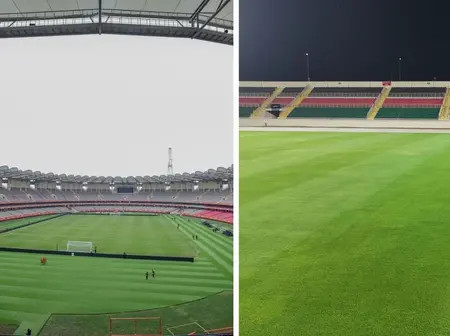Harambee Stars is Kenya’s foremost national football team and here is all you need to know about them.
Harambee Stars is Kenya’s main national football team which is also a symbol of unity as it flies the country’s flag on the international stage.
The team, as currently known, was founded in 1961, having been under British rule before the country got independence, with its first coach being Englishman Ray Batchelor.
Harambee Stars draws its name from the Swahili word Harambee which means ‘all pull together’ as it embodies the country’s spirit of togetherness.
PAY ATTENTION: Stay updated with the Latest Sports News in Kenya from Pulse Sports
The Harambee Stars have traditionally played their home matches at either the Kasarani or Nyayo Stadiums and will soon shift base to the Talanta Sports City Stadium that is currently under construction with its completion date projected to be December 2025.
Since its formation in 1961, Harambee Stars have featured in a number of matches, including World Cup qualifiers, Africa Cup of Nations, regional tournaments like CECAFA (Gossage Cup) and COSAFA as well as invitational and friendly matches.
Harambee Stars’ best result was witnessed on October 4, 1961, when they beat Zanzibar 10-0, but the result came 29 years after suffering their worst defeat, a 13-1 loss to Uganda on December 14, 1932 when they were still a British colony.
Harambee Stars have tried without success to qualify for the FIFA World Cup over the years failing at the qualification stage.
From 1930-1958, Kenya was still under the United Kingdom but declined to participate in FIFA events from 1962-1970, having formed their own national team.
However, since then, they have been part of the international football community but have always fallen at the first round of World Cup qualifiers with their best possible opportunity being in 2030 when Portugal, Spain and Morocco will co-host the tournament.
While they have never been to the World Cup, Harambee Stars have been to the Africa Cup of Nations six times with their last appearance being in 2019.
Kenya featured at the 1972, 1988, 1990, 1992, 2004 and 2019 tournaments but in all of them, they were eliminated at the group stage, with their best results witnessed at their last two appearances, when they won one match apiece.
Since its first edition in 2009, Kenya had never qualified for the tournament, reserved only for players featuring in their local leagues, but made it to the delayed CHAN 2024 by virtue of being co-hosts alongside Uganda and Tanzania.
It was an impressive debut as the Benni McCarthy-led team reached the quarter-final, where they were eliminated on post-match penalties by Madagascar, after finishing top from a group that had Morocco, DR Congo, Angola and Zambia.
Harambee Stars are part of the Council for East and Central Africa Football Associations (CECAFA) where they have won seven titles (1975, 1981, 1982, 1983, 2002, 2013, 2017) and have finished second as many times with third place six times.
Before independence, the tournament was known as Gossage Cup, played between 1926 and 1966, and it brought together Kenya, Uganda, Tanganyika and Zanzibar. Kenya won the Gossage Cup 14 times in 1926, 1931, 1941, 1942, 1944, 1946, 1953, 1958, 1959, 1960 (shared), 1961, 1966, 1967 and 1971.
They have also been an invitational team at the Council of Southern Africa Football Associations (COSAFA), twice in 2013 and 2024, but exited at the group stage.
Harambee Stars also featured at the 1987 All Africa Games (now African Games), which Kenya hosted, and finished second after losing 1-0 to Egypt in the final.
Harambee Stars have witnessed a number of prolific forwards over the years but William Ouma remains the country’s all-time top scorer with 35 goals, achieved in 66 games from 1965-1977, with Dennis Oliech and Michael Olunga joint second with 34 goals each from 67 and 76 caps respectively.
Elijah Lidonde remains Kenya’s most lethal striker as he netted 33 goals in just 26 games from 1950-1961.
Longest-serving Harambee Stars captain Musa Otieno played the most games for Kenya, having earned 90 caps from 1993-2009, followed by Jonathan Niva, who had 88 caps from 1965-1976.
Allan Thigo had 81 appearances between 1969-1978, John Nyawanga managing 80 caps from 1965-1976 while Dennis Oliech completes the top five with 76 caps earned between 2002 and 2015.
There has never been a consensus on who is Harambee Stars’ most successful coach but German Reinhard Fabisch, who had three stints with the team, and Marshall Mulwa have received wide acclaim.
Fabisch led the team first from 1987-1988 before a second stint in 1997 and then from 2001-2002. However, it is during his first stint that he has been praised as he guided Harambee Stars to silver at the 1987 All Africa Games and then to the 1988 Africa Cup of Nations.
Meanwhile, Mulwa, who coached Harambee Stars from 1980-1983, won three consecutive CECAFA titles from 1981, 1982 to 1983.
Kenya had their highest-ever FIFA ranking in December 2008, then under coach Francis Kimanzi, following a string of impressive performances, but would experience their lowest in July 2007 when they sunk to position 137.
)
Harambee Stars have also faced the wrath of FIFA a number of times with their first suspension in 2004 following government interference with the ban reversed after three months after the country agreed to create new statutes.
However, on October 25, 2006, Kenya was again suspended from international football, for failing to fulfil a January 2006 agreement made to resolve recurrent problems in its federation.
‘Big Brother’ would strike again in February 2022 when Kenya was suspended from all football activities due to government interference when the Sports Ministry disbanded Football Kenya Federation and created a caretaker committee over allegations of corruption against its officials.
The ban saw Kenya fail to feature in the 2023 AFCON qualifiers and it was not until November 2022 that FIFA lifted the suspension after the government agreed to reinstate FKF.

Leave a Reply